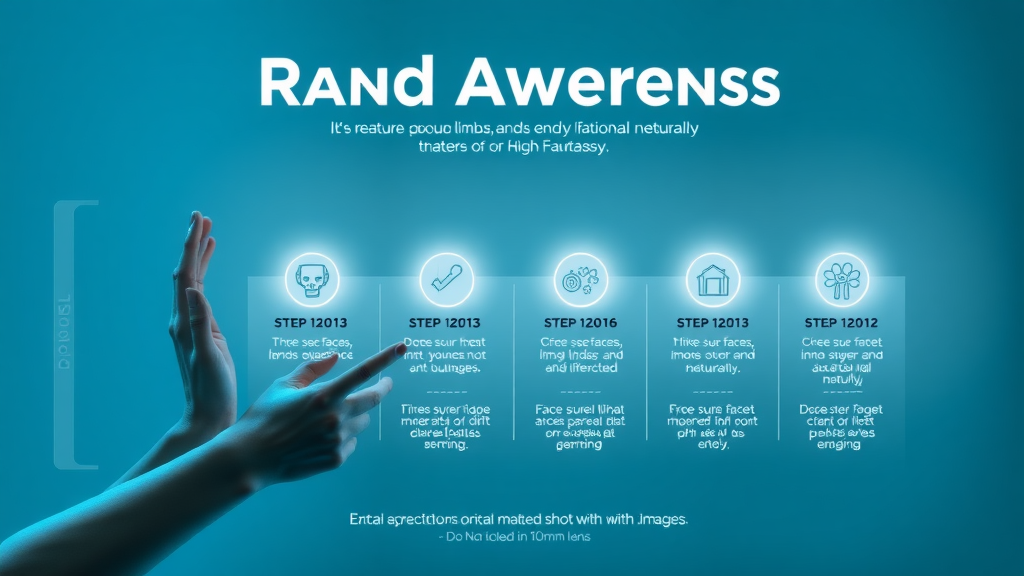Did you know that 89% of marketers say brand awareness is their top goal, yet most brands still miss out on exponential growth simply because people don’t recognize or remember them? In today’s digital marketplace, brand awareness isn’t just a marketing buzzword—it’s the key driver of business success, from stronger customer loyalty to measurable growth. This comprehensive guide unpacks powerful, proven tactics to boost brand awareness, helping your business stand out and thrive.
Startling Facts: Why Brand Awareness is Your Business Powerhouse
According to a Nielsen study, 59% of consumers prefer to buy new products from brands familiar to them, highlighting that brand awareness directly influences purchasing decisions. Brand recognition goes far beyond just having your logo seen; it’s about building trust, credibility, and a positive brand image that resonates with your target audience. As businesses navigate crowded markets, establishing strong brand awareness is essential not only for standing out but also for cultivating long-term customer loyalty. In fact, brands with high awareness are more likely to drive repeated sales and command higher price points—clear evidence of the direct link between brand awareness and brand equity.
Incorporating brand recall into your marketing strategies significantly boosts your brand’s influence, ensuring your offerings are top-of-mind when customers make a purchasing decision. By consistently measuring brand awareness and adjusting your tactics, you not only increase your reach but also optimize your return on investment for every marketing campaign you run.

What You'll Learn About Brand Awareness
- The definition and key concepts of brand awareness
- How to build brand awareness effectively
- Proven tactics for increasing brand awareness
- Strategies for measuring brand awareness success
- Insights into leveraging social media for brand recognition and recall
- Expert tips and actionable takeaways to boost your brand
As you explore the strategies for building brand awareness, it’s important to recognize the pivotal role content marketing plays in this process. For actionable advice on creating high-impact content that drives both recognition and engagement, check out these content marketing tips that drive massive traffic and support your brand’s growth objectives.
Understanding Brand Awareness: Definitions, Importance, and Impact
What is Brand Awareness? Core Concepts Explained
Brand awareness refers to how well your target audience recognizes and remembers your brand when they see it or hear your name. This stretches beyond brand recognition—it's the degree to which your audience can recall your brand, understand what it stands for, and distinguish it from competitors. At its core, brand awareness is about embedding your products or services into the minds of customers, making your company the default choice when a relevant need arises. When you successfully build brand awareness, you create “mind awareness”—a state where your brand is the first that comes to mind in your niche.
Establishing strong brand awareness involves more than just visual identity or catchy slogans; it is a strategic process encompassing messaging, brand story, and positive associations. Understanding these brand awareness concepts is crucial for any business striving to forge deep, lasting connections with their audience and ensure their marketing strategies stand out amid the competition.

Why Brand Awareness is Foundational to Brand Equity and Growth
If you want your business to thrive long-term, brand awareness is non-negotiable. High levels of brand awareness lead to strong brand equity, or the added value a familiar brand brings to its products and services. This brand equity translates to customer trust, willingness to choose your offerings over others, and even pay a premium. It is no surprise that brands with high brand awareness consistently outperform their lesser-known counterparts across almost every metric—awareness breeds loyalty, and loyalty drives sustained growth.
"Brand awareness is the first step in building a strong brand and driving customer loyalty."
Ultimately, brand awareness campaigns lay the groundwork for all other branding and marketing efforts. Without it, even the best product or service risks being overlooked by the buying public. Investing in building brand awareness pays dividends—not just in improved recognition, but in creating meaningful relationships that fuel expansion.
The Relationship Between Brand Awareness and Brand Recognition
While these terms are often used interchangeably, brand recognition refers to a customer’s ability to visually or emotionally identify aspects of your brand—such as the logo, colors, or packaging—without needing direct cues. Brand awareness encompasses this but also includes deeper recall: remembering your name and associating it with certain qualities, solutions, or values. Strong brand recognition is an entry point; true brand awareness is when your brand becomes woven into customer choices and perceptions.
The relationship between brand awareness and brand recognition is symbiotic. When your company invests in visual identity and consistent messaging, you pave the way for familiarity, trust, and recall. Positioning your brand as recognizable helps potential customers feel more comfortable, increases the likelihood of repeat business, and makes your marketing campaigns much more effective.
Brand Recall, Mind Awareness, and Brand Equity: Essential Distinctions
Brand recall is a powerful tier of brand awareness. It is the level at which your target audience can retrieve your brand from memory when prompted by a product category. For instance, what comes to mind when you think of athletic shoes or smartphone brands? Achieving high brand recall results in better performance at key moments in the purchase decision process. Mind awareness takes this further—meaning your brand is the first or only one a consumer recalls when considering a specific need, a coveted “top-of-mind” status. Combined with brand equity, these elements form the backbone of a winning branding strategy.
Understanding these essential brand distinctions enables companies to align their marketing efforts with business growth goals. A great brand strategy ensures consumers not only recognize your brand but also recall it with positive associations—ultimately driving purchase decisions and enhancing customer loyalty.

People Also Ask: Core Brand Awareness Questions
What do you mean by brand awareness?
Brand awareness refers to the extent to which consumers are familiar with and can recognize a particular brand. It measures how well a target audience can recall or recognize a brand and associate it with specific products or services.
What are the 4 levels of brand awareness?

The four levels are: (1) No Awareness, (2) Brand Recognition, (3) Brand Recall, and (4) Top-of-Mind Awareness. Each level reflects a deeper relationship between your brand and your audience. Moving up these levels means your targets not only remember your name but automatically think of your brand when discussing a relevant category. Striving for top-of-mind awareness is a hallmark of strong, effective brand strategy, and it is crucial for ensuring ongoing business growth.
What are the 7 brand elements?
The 7 brand elements are: Name, Logo, Tagline, Color Scheme, Graphic Elements, Typography, and Brand Voice. These work together to create a cohesive and recognizable brand image. Ensuring consistency across these elements ensures that your audience can identify your brand across multiple touchpoints, from a media post to product packaging and beyond. Harmonized brand elements foster familiarity, trust, and strong brand equity.
What is considered good brand awareness?
Good brand awareness is when a substantial portion of your target audience can recall or recognize your brand without prompts, showing strong brand recall and high brand equity. The benchmark for “good” awareness depends on your industry and goals, but ideally, you want your brand to be top-of-mind when customers consider your product or service category. Consistently measuring brand awareness helps ensure your brand is achieving (and maintaining) these valuable associations in the marketplace.
Breaking Down Brand Awareness: Terms, Levels, and Market Impact
Key Terms: Brand Recall, Brand Recognition, Top-of-Mind, and Aided Brand Awareness
To fully understand and build brand awareness, it’s important to clarify four core terms:
- Brand Recall: The ability of customers to retrieve a brand from memory without prompts when considering a product or service category.
- Brand Recognition: The extent to which a customer can confirm prior exposure to your brand when given visual or aural cues—like a logo or slogan.
- Top-of-Mind Awareness: When your brand is the first that comes to mind for consumers in your industry or product category, reflecting the ultimate in mind awareness.
- Aided Brand Awareness: When a customer recognizes your brand only after being presented with a list or set of options, rather than unprompted.
These terms impact how you measure brand awareness and set targets for improvement. Differentiating between them ensures you tailor your marketing strategies effectively, driving overall market impact and lasting brand equity.
How Strong Brand Awareness Drives Marketing Campaign Success
A strong brand awareness foundation amplifies every marketing effort. Campaigns for established brands often achieve higher engagement and conversion rates, as consumers naturally gravitate to what’s familiar. This familiarity lowers barriers to purchase, speeds up the buying process, and supports positive brand associations that influence future purchasing decisions. Businesses with elevated brand awareness benefit from improved customer trust, more effective media spend, and stronger word-of-mouth referrals.
Marketing teams consistently report that investing in building brand awareness leads not only to increased sales but also to meaningful, long-term customer relationships. Regardless of your industry, your marketing campaign will yield far better results when built on a strong awareness base. Measure brand awareness regularly to see the tangible impact of your brand-building initiatives over time.

Building Brand Equity: The Cornerstone of Modern Marketing
Brand equity is the cumulative value that a recognizable brand brings to your company—leading to higher retention rates, greater pricing power, and sustained marketing ROI. Building strong brand awareness is the first step toward long-lasting brand equity. Every impression, interaction, and engagement designed to increase brand awareness contributes to creating positive customer experiences and perceptions.
The more consistently you nurture brand equity through effective awareness-building tactics, the more easily your brand weathers changing trends and market disruptions. Brands with strong brand equity are seen as industry leaders, trusted by customers, and more likely to drive advocacy and referrals. Investing in your brand’s visibility today pays long-term dividends across all future marketing endeavors.
Proven Tactics to Build Brand Awareness in Any Market
- Strategic social media marketing campaign planning
- Creating memorable branding and brand imagery
- Leveraging influencer and partnership marketing
- Utilizing content marketing for brand recall
- Optimizing for brand recognition in your target audience
- Using social listening tools to monitor mind awareness
Innovative Social Media Strategies to Increase Brand Awareness
Social media is one of the most effective vehicles for building brand awareness. By showcasing relatable stories, creative visuals, and consistent messaging across channels—like Instagram, Facebook, TikTok, and LinkedIn—you tap into vast networks and facilitate organic sharing. Planning campaigns that leverage platform-specific features (Stories, Reels, Live Streams) allows you to reach your target audience in authentic, engaging ways. Invest in tailored content creation that matches each platform’s culture, as this significantly increases brand awareness and recall.
Embracing social listening and analytics empowers you to identify trending topics and join conversations relevant to your brand. Monitoring keywords and hashtags related to your products or services also moves audiences from passive viewers to active participants. Regular, targeted social media post updates and community management will boost mind awareness and cement your brand’s presence in the digital marketplace.

Building a Strong Brand Image through Content and Storytelling
Your brand image is shaped not only by how you look but also by the stories you tell. Effective content marketing—through blogs, videos, podcasts, and infographics—helps your business build deeper emotional connections and memorable associations. Storytelling humanizes your brand, relays your values, and establishes your authority, all critical factors for lasting brand awareness and positive brand equity. When your content resonates, your target audience is more likely to engage, recommend, and remember your company.
To strengthen your brand image, invest in quality content that addresses your audience’s problems, showcases your solutions, and highlights customer success stories. These narratives foster trust and elevate your brand in the minds of consumers, ensuring you remain top-of-mind long after the initial contact. Consistency and creativity in storytelling are your secret weapon for building a powerful, recognizable brand presence.
Leveraging Influencer Marketing and Collaborative Campaigns
Influencer partnerships extend your reach exponentially, introducing your brand to new, highly relevant audiences. By collaborating with trusted voices in your industry, you borrow their credibility and increase the visibility of your products and services. These partnerships can take various forms: sponsored content, joint giveaways, co-created campaigns, or reviews. Each allows authentic endorsements that prompt followers to research, engage with, and remember your brand—significantly boosting brand awareness and recognition.
Successful influencer marketing doesn’t always require mega-celebrities. Micro-influencers often drive high ROI, as their audiences are highly engaged and focused. When building brand awareness, choose influencers whose values and audience align with your own. Use collaborative campaigns to showcase your brand’s unique proposition and drive engagement, recall, and loyalty among your ideal customers.
Maximizing the Impact of Visual Content for Brand Recognition
Visual content is the cornerstone of brand recognition. Logo designs, color palettes, photography styles, and graphic motifs should remain consistent across all your materials—from your website to every social media post. Cohesive and unique visual branding sets your company apart, making your communications instantly recognizable. Infographics, short-form videos, and visually-rich stories help simplify complex topics and increase shareability, broadening your reach and strengthening mind awareness.
Encourage user-generated content—such as reviews with photos or branded hashtags on social media. These organic interactions reinforce your visual branding and help build credibility among new audience segments. The more often your audience encounters your visual identity, the stronger your brand recognition and the easier it becomes to achieve top-of-mind awareness.

Target Audience Mastery: How to Build Brand Awareness that Resonates
Defining and Segmenting Your Target Audience
Knowing exactly who you want to reach is the foundation of building brand awareness that delivers real business results. Start by defining demographic criteria—such as age, location, gender, and income—then dig deeper into psychographics (interests, values, pain points). Use digital tools and analytics, including Google Analytics and social listening, to segment your customer base for even more effective targeting. Segmentation ensures your messages reach the right people, increasing both efficiency and the likelihood of customer engagement and recall.
Understanding your target audience reduces wasted effort and enables you to build brand awareness with those most likely to buy, advocate, and remain loyal. The more detailed your audience profiles, the better you can design personalized campaigns that break through the noise and drive sustained results.

Tailoring Marketing Campaigns for Brand Equity Growth
No two audiences are exactly alike, so your marketing campaigns should align with each segment’s needs and preferences. Customize campaigns with language, visuals, and value propositions tailored to specific groups, increasing resonance and recall. Implement feedback loops to gather insights—from social listening to direct customer interactions—then refine your approach for continuous brand equity growth.
Data-driven strategies ensure that each touchpoint, from email marketing to event sponsorships, maximizes the potential to increase brand awareness and strengthen customer loyalty. Track performance metrics for every campaign, adapt quickly to audience preferences, and watch your brand equity soar. Personalized, relevant marketing is now the gold standard for building long-lasting awareness and advocacy.
Brand Messaging that Drives Mind Awareness and Recall
Crafting clear and consistent messaging is critical to embedding your brand in the minds of consumers. Develop a brand voice that’s authentic, relatable, and memorable—whether playful, professional, or inspirational. Integrate your core values and key differentiators into every brand story and marketing asset, so your audience quickly recognizes what sets you apart.
Repetition is key for brand recall and mind awareness—ensure your messaging appears across every channel your audience frequents. This alignment boosts familiarity and makes it easier for consumers to remember and choose your products or services in moments of need.
Measuring Brand Awareness: Key Metrics and Proven Tools
| Metric | Definition | Best Use Case |
|---|---|---|
| Impressions | Total number of times your content is displayed to users | Assessing content reach across social media and ad platforms |
| Reach | Count of unique users who see your brand’s content | Understanding overall audience size and potential market |
| Brand Recall | Percentage of people who remember your brand unprompted | Measuring campaign memorability and lasting impact |
| Brand Recognition | Number of consumers who recognize your brand with a prompt or cue | Evaluating logo, imagery, or slogan effectiveness |
| Surveys | Direct feedback on brand presence and perception from your audience | In-depth insights for strategic decisions and improvements |
| Social Listening | Monitoring conversations and sentiment about your brand online | Continuous analysis of public perception and campaign effectiveness |
How to Measure Brand Awareness Effectively
A blend of quantitative and qualitative metrics is essential to accurately measure brand awareness. Use digital analytics platforms—like Google Analytics for website traffic, or native dashboard stats on social channels—to track impressions, reach, and engagement rates. Supplement these with periodic brand surveys to uncover deeper insights into recall and overall perception among your target audience.
Employ social listening tools to monitor mentions, sentiment, and key topics surrounding your brand in real-time. This provides context for both positive and negative conversations, allowing you to adapt messaging and address concerns promptly. Setting clear KPIs for increase brand awareness, such as improved brand recall or higher aided brand recognition scores, helps align your team around tangible goals and drive continuous improvement.

Top Tools for Tracking Brand Awareness and Brand Equity
Several user-friendly and powerful tools exist to measure brand awareness and track brand equity over time. Google Analytics remains a staple for analyzing web traffic and branded search volume, making it easy to spot surges in brand interest. Social media analytics tools like Sprout Social, Hootsuite, and Buffer offer real-time monitoring of engagement, share of voice, and conversation sentiment—perfect for tracking social media-based brand awareness initiatives.
For in-depth analysis, use specialized brand tracking platforms such as Brandwatch or Mention, which combine social listening with competitive benchmarks and historical insights. These tools help you identify which tactics are working, so you can optimize campaigns and continue to build brand awareness efficiently.
Using Social Listening and Analytics to Measure and Improve Brand Performance
Social listening platforms track every mention of your brand, product, or competitors, offering valuable insights into customer perceptions and top-of-mind awareness. Advanced AI-powered tools provide not only mention counts and sentiment analysis but also inform content strategy by highlighting trending topics among your audience. Use these insights to refine messaging, address challenges early, and continuously increase brand awareness.
Pair data from social listening with analytics dashboards to identify correlations between campaign activity and spikes in brand recall or positive sentiment. This comprehensive approach connects the dots between tactics and measurable business outcomes, ensuring your marketing strategies deliver maximum impact and consistent brand equity growth.
Real-Life Success Stories: Companies Excelling at Building Brand Awareness
Case Study: Leveraging Social Media to Build Brand Awareness
"Our innovative content strategy resulted in a 40% improvement in brand recall within our target audience."
Consider a retail brand that revamped its social media presence by prioritizing creative visuals and audience-driven storytelling. By regularly engaging customers with question-based posts, behind-the-scenes videos, and influencer takeovers, they saw measurable jumps in both engagement rates and brand recall. Month-over-month improvements in top-of-mind awareness ultimately led to a double-digit increase in conversion rates.

Global Brands and Their Brand Recognition Strategies
Global leaders like Nike, Apple, and Coca-Cola have mastered brand recognition by leveraging omnichannel campaigns, unique storytelling, and consistent visual identities. Nike, for example, uses influencer partnerships and motivational storytelling in every marketing campaign, ensuring its swoosh symbol is instantly tied to performance and innovation. Apple’s minimalist design and consistent messaging create a seamless brand experience—online, in-store, or in media post—cementing awareness across all touchpoints.
These brands measure brand awareness regularly, continually adjust their strategies, and use data-driven insights to reinforce their position as category leaders. By emulating these approaches—personalization, repetition, and authenticity—you can achieve lasting awareness, regardless of your business size or industry.
Common Mistakes and How to Avoid Them When Building Brand Awareness
- Ignoring your target audience's needs
- Underestimating the importance of brand equity
- Inconsistent brand messaging across platforms
- Neglecting to measure brand awareness
- Overlooking the power of social media in brand building
Advanced Tactics for Building Strong Brand Awareness
Innovative Ways to Increase Brand Awareness in Your Niche
To outpace competitors in your niche, experiment with emerging digital platforms (e.g., TikTok, Clubhouse), interactive experiences (live Q&A, virtual events), or co-branded partnerships that increase your reach. Consider launching user-generated content contests or mobile-first campaigns to engage audiences where they’re most active. Regularly analyze keywords with high purchase intent to optimize search engine presence, further boosting brand recall and bringing new prospects into your funnel.
Integrate branded storytelling and immersive content—such as AR filters or shoppable posts—into your marketing to enhance both recall and recognition among younger digital audiences. Tracking these novel tactics with analytics is crucial to ensure ongoing success and scalability.
How to Sustain and Grow Brand Recognition Over Time
Achieving brand recognition is only the beginning; sustaining it requires ongoing effort. Refresh your content strategy regularly, keeping visuals and messaging in tune with evolving market trends, but maintain core elements for brand consistency. Don’t abandon traditional marketing—balance digital with print, in-person events, and sponsorships for maximum reach.
Collect customer testimonials and reviews, feature success stories, and encourage referrals through loyalty programs. Sustaining brand awareness over time is about nurturing community, rewarding advocacy, and always delivering on your promises to retain and win over new fans.

Leveraging Brand Equity for Long-Term Success
As your business matures, focus on converting strong brand awareness into robust brand equity. Reinforce your core values through every customer interaction, champion customer service, and remain responsive to feedback. Use data from social listening and surveys to continuously adapt, upholding your brand image and value proposition. Over time, this approach turns awareness into loyalty, making your brand a trusted staple in your industry and ensuring long-term competitive advantage.
By staying true to your brand’s mission and consistently delivering value, you lay the groundwork for organic referrals and generational loyalty—hallmarks of world-class brand equity.
Key Takeaways: Boosting Your Brand Awareness Effectively
- Brand awareness is the foundation of brand equity and long-term growth
- Use a combination of social media, content marketing, and influencer campaigns
- Always measure and adapt your brand awareness strategies
- Deep understanding of your target audience leads to lasting brand recognition
Frequently Asked Questions About Brand Awareness
-
How often should I measure brand awareness?
It's best to measure brand awareness quarterly or after significant marketing campaign launches. Continuous social listening and periodic surveys keep you aware of shifts in market perception, letting you adapt strategies promptly for better results. -
What is the difference between brand recognition and brand recall?
Brand recognition is when people identify your brand after seeing visual cues (like a logo), whereas brand recall is when they remember your brand name unprompted, demonstrating deeper mind awareness and stronger brand equity. -
Can small businesses compete with large companies in brand awareness?
Absolutely. By focusing on niche audiences, authentic stories, and targeted digital campaigns, small businesses can build meaningful awareness and engagement—often with agility that large companies lack. -
Which social media platforms are best for building brand awareness?
Instagram, Facebook, TikTok, YouTube, and LinkedIn are all excellent choices. The best platforms depend on your target audience—analyze their preferences and habits to maximize your reach and engagement. -
How long does it take to see results from brand awareness campaigns?
Timelines vary, but most organizations see measurable improvements within three to six months of sustained, strategic effort—especially when regularly measuring metrics and optimizing as needed.
Ready to Increase Brand Awareness? Next Steps and Resources
For more information read The Ultimate Guide to Social Media Marketing: Strategy, Platforms, Channels, and Tips to Win, and How to Build a Winning Plan.
Conclusion: Transform Your Business with Proven Brand Awareness Strategies
Recap the most important brand awareness insights and urge readers to start implementing these proven tactics for measurable results. Need Help? Call Digital Media Marketing at 1-586-997-0001
If you’re ready to take your brand’s visibility to the next level, consider how a holistic digital marketing approach can amplify your efforts. Exploring the broader landscape of digital marketing can reveal breakthrough opportunities for growth, integration, and innovation. For a deeper dive into how digital marketing strategies can transform your business and unlock new potential, discover whether digital marketing is the breakthrough you’ve been waiting for. Elevate your brand by combining awareness tactics with a comprehensive digital strategy that positions you ahead of the competition.
 Add Row
Add Row  Add
Add 




Write A Comment